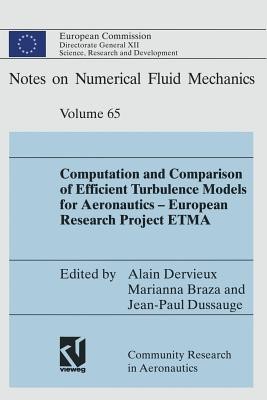
- We will send in 10–14 business days.
- Publisher: Vieweg+Teubner Verlag
- Year: 2012
- Pages: 581
- ISBN-10: 332289861X
- ISBN-13: 9783322898616
- Format: 15.6 x 23.4 x 3.1 cm, softcover
- Language: English
- SAVE -10% with code: EXTRA
Computation and Comparison of Efficient Turbulence Models for Aeronautics -- European Research Project Etma (e-book) (used book) | bookbook.eu
Reviews
Description
The computation of complex turbulent flows by statistical modelling has already a long history. The most popular two-equation models today were introduced in the early sev- enties. However these models have been generally tested in rather academic cases. The develope- ment of computers has led to more and more acurate numerical methods. The interactions betwe n numerical and modelling techniques are generally not well mastered. Moreover, computation of real life cases, including 3D effects, complex geometries and pressure gra- dients based on two-equation models with low-Reynolds treatment at the proximity of walls are not really of common use. A large number of models has been proposed; this is perhaps the sign that none of them is really satisfactory, and then the assessment of their generality is not an easy task: it requires a lot of understanding of the physics and a lot of work for testing the large number of relevant cases in order to assess their limits of validity which is a condition for an improved confidence in engineering applications. This is probably why workshops and working groups are frequent and the ETMA consor- tium has choosen to build a state of the art in theoretical and numerical statistical turbu- lence modelling for real life computations by taking some marks with respect to previous workshops such as the Stanford meetings (1980,1981); some problems are kept or updated by new experiments, some problems are discarded, some new problems are introduced; the focus is kept on flows with 2D geometries.
EXTRA 10 % discount with code: EXTRA
The promotion ends in 20d.07:55:06
The discount code is valid when purchasing from 10 €. Discounts do not stack.
- Publisher: Vieweg+Teubner Verlag
- Year: 2012
- Pages: 581
- ISBN-10: 332289861X
- ISBN-13: 9783322898616
- Format: 15.6 x 23.4 x 3.1 cm, softcover
- Language: English English
The computation of complex turbulent flows by statistical modelling has already a long history. The most popular two-equation models today were introduced in the early sev- enties. However these models have been generally tested in rather academic cases. The develope- ment of computers has led to more and more acurate numerical methods. The interactions betwe n numerical and modelling techniques are generally not well mastered. Moreover, computation of real life cases, including 3D effects, complex geometries and pressure gra- dients based on two-equation models with low-Reynolds treatment at the proximity of walls are not really of common use. A large number of models has been proposed; this is perhaps the sign that none of them is really satisfactory, and then the assessment of their generality is not an easy task: it requires a lot of understanding of the physics and a lot of work for testing the large number of relevant cases in order to assess their limits of validity which is a condition for an improved confidence in engineering applications. This is probably why workshops and working groups are frequent and the ETMA consor- tium has choosen to build a state of the art in theoretical and numerical statistical turbu- lence modelling for real life computations by taking some marks with respect to previous workshops such as the Stanford meetings (1980,1981); some problems are kept or updated by new experiments, some problems are discarded, some new problems are introduced; the focus is kept on flows with 2D geometries.


Reviews